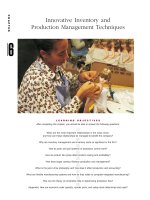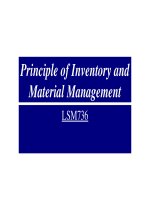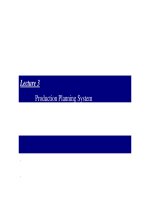Lecture Principle of inventory and material management - Lecture 9
Bạn đang xem bản rút gọn của tài liệu. Xem và tải ngay bản đầy đủ của tài liệu tại đây (512.46 KB, 45 trang )
Lecture 9
Materials Requirements Planning
Books
•
Introduction to Materials Management, Sixth Edition, J. R. Tony Arnold, P.E., CFPIM, CIRM, Fleming
College, Emeritus, Stephen N. Chapman, Ph.D., CFPIM, North Carolina State University, Lloyd M.
Clive, P.E., CFPIM, Fleming College
•
Operations Management for Competitive Advantage, 11th Edition, by Chase, Jacobs, and Aquilano, 2005,
N.Y.: McGrawHill/Irwin.
•
Operations Management, 11/E, Jay Heizer, Texas Lutheran University, Barry Render, Graduate School of
Business, Rollins College, Prentice Hall
Objectives
•
•
•
•
•
Material Requirement Planning
Nature of Demand
Inputs to MRP
Bill of Material
Planned Orders
Material Requirements Planning
•
•
•
Material Requirements Planning is a system to calculate
requirements for dependent demand items
It establishes a schedule (priority plan) showing the
components required at each level of the assembly and, based
on lead times, calculates the time when these components will
be needed
It is a system to avoid missing parts for the end item
Material Requirements Planning Process
•
We need to determine
–
–
–
•
What to order
How much to order
When to order
This will involve
–
–
–
–
Lead times
Bills of material
Inventory Status
Planning data
Nature of Demand
•
Two Types of Demand
–
Independent
•
•
–
Is not related to the demand for any other product and must be
forecast
Master production schedule (MPS) items are independent
demand items
Dependent
•
•
Is directly related to other items or end items
Such demand should be calculated and need not and should
not be forecast
Nature of Demand
Independent Demand
(Forecast)
Table
Legs
(4)
Ends
(2)
Sides
(2)
Item
#206
Item
#433
Item
#711
Top
(1)
Item
#025
Hardware Dependent Demand
Kit (1)
(Calculated)
Item
#822
If you have an order for 23 Tables, what components
would you need to produce them?
Objectives of MRP
•
Two Major Objectives
– Determine Requirements
•
•
•
•
–
What to order
How much to order
When to order
When to schedule delivery
Keep Priorities Current
•
It must be able to add and delete, expedite, delay, and
change orders based upon present priorities
Linkages with Other Manufacturing Planning
and Control Functions
Business
Plan
Production
Plan
Planning
MPS
MRP
PC and
Purchasing
The MRP is driven by
the MPS; it is concerned
with the components
needed to make the
end items.
•
The MRP in turn drives,
or is input to, production
control (PC) and purchasing
•
Execution
Inputs to the MRP System
•
MPS
Inventory
Status
MRP
Four Major Inputs:
–
Bill of
Material
–
–
–
Planning
Data
Master Production
Schedule
Inventory Records
Planning Data
Bills of Material
Inputs to the MRP System
•
Master Production Schedule (MPS)
–
•
The MPS provides information on planned and scheduled
orders for end items (how much is wanted and when)
Inventory Status
–
Inventory status provides information on what is already
available. Inventory records include the status of each item,
including amounts on order and on hand and the location
Inputs to the MRP System
•
Bills of Material
–
•
Planning Data
–
•
Bills of material describe components and the quantity of each needed to
make one unit
Planning data include lot size, lead time, scrap factors, yield factors, and
safety stock
The Computer
–
Computers are needed because they are fast , accurate, and have the
ability to store and manipulate data and produce information rapidly
Bills of Material
Bill of Material
“a listing of all the subassemblies, intermediates, parts, and raw materials
that go into making the parent assembly showing the quantities of each
required to make an assembly”
APICS Dictionary, 8th edition, 1995
•
•
The bill of material shows all the parts required to make one of
the item
Each part or item has only one part number
Bills of Material
•
Parent–Component Relationship
–
An assembly is considered a parent, and the items that comprise it are
called its component items.
Parent
Table
Legs
(4)
Ends
(2)
Sides
(2)
Top
(1)
Hardware
Kit (1)
Item
#206
Item
#433
Item
#711
Item
#025
Item
#822
Component
Bills of Material
•
•
•
•
The multilevel bill is made up of subassemblies. The
subassemblies reflect the way manufacturing plans to build the
product.
The lowest items on the bill are usually purchased parts.
All parts and subassemblies have unique numbers.
By convention, the final assembly is considered level zero.
Levels down the bill are numbered consecutively.
Bills of Material
•
•
•
The multilevel bill is a collection of singlelevel bills. Each
singlelevel bill shows the parts to make one parent.
To reduce storage space and to make maintenance easier, the
computer stores singlelevel bills only.
Items can be both parents of components and components of
other parents.
Bills of Material
•
LowLevel Coding and Netting A component may reside on
more than one level in a bill of material
–
–
–
The lowlevel code is the lowest level on which a part resides in all bills
of material. Every part has only one lowlevel code.
Lowlevel are determined by starting at the lowest level of a bill of
material and, working up, recording the level against the part. If a part
occurs on a higher level, its existence on the lower level has already
been recorded.
Once the lowlevel codes are obtained, the net requirements for each
part can be calculated.
Bills of Material
•
Uses for Bills of Material
–
–
–
–
–
–
–
–
•
Product Definition
Engineering Change Control
Service Parts
Planning
Order Entry
Manufacturing
Costing
Etc.
Maintaining bills of material and their accuracy is extremely
important
Bills of Material
List of components, ingredients, and
materials needed to make product
þ
Provides product structure
þ
Items above given level are called
parents
þ
Items below given level are called
children
þ
BOM Example
Level
Product structure for “Awesome” (A)
0
A
E(2)
2
3
12” Speaker kit w/
C(3) Std.
amp-booster
B(2) Std. 12” Speaker kit
1
D(2)
F(2) Std. 12” Speaker
E(2)
Packing box and
installation kit of wire,
bolts, and screws
booster assembly
G(1)
D(2)
Amp-booster
12” Speaker
12” Speaker
BOM Example
Level
Product structure for “Awesome” (A)
0
A
Part B: 2 x number of As =
(2)(50) =
100
12” Speaker 150
kit w/
PartStd.
C: 12”3Speaker
x number
(3)(50)
B(2)
kit of As =
C(3) =Std.
1
amp-booster
Part D: 2 x number of Bs
+ 2 x number of Fs = (2)(100) + (2)(300) = 800
Part E:
E(2) 2 x number of Bs
E(2)
F(2) Std. 12” Speaker
2
booster
+ 2 x number of Cs = (2)(100) + (2)(150)
= assembly
500
Part F:
2 x number
of Cs =
(2)(150) =
300
Packing box and
numberkitofofFs
=
(1)(300)
300
wire,
G(1) =
D(2)
3 D(2) Part G: 1 xinstallation
bolts, and screws
Amp-booster
12” Speaker
12” Speaker
Bills of Material
þ
Modular Bills
Modules are not final products but
components that can be assembled
into multiple end items
þ
Can significantly simplify planning and
scheduling
þ
Bills of Material
þ
Planning Bills (Pseudo Bills)
Created to assign an artificial parent to
the BOM
þ
Used to group subassemblies to
reduce the number of items planned
and scheduled
þ
Used to create standard “kits” for
production
þ
Bills of Material
þ
Phantom Bills
Describe subassemblies that exist only
temporarily
þ
Are part of another assembly and
never go into inventory
þ
þ
Low-Level Coding
Item is coded at the lowest level at which
it occurs
þ
BOMs are processed one level at a time
þ
Lead Times, Exploding, and Offsetting
A
LT: 2 wk
LT: 1 wk
•
•
•
D
B
LT: 1 wk
C
E
LT: 1 wk
LT: 1 wk
Lead time: The time from when an order is placed until the part is
ready for use.
Exploding: Multiplying the parent requirements by the usage
quantity through the product tree
Offsetting: Placing the requirements in their proper time
periods
based on lead times
Planned Orders
•
•
•
Planned Order Receipt
– That quantity planned to be received at a future date as a
result of a planned order release.
Planned Order Release
– Planned order releases are just planned; they have not been
released. Orders for material should not be released until the
planned order release date arrives.
The planned order release of the parent becomes the gross
requirement of the component.









